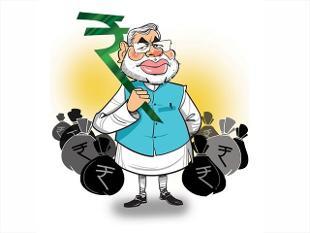How to Shrink the Economy in 50 Days?

The government cannot hide the truth anymore - Indian economy is shrinking. Though, the government is still projecting a rosy picture of 7.1% growth rate for the year 2016-17, only slightly lower than 7.6% of the previous year. While we know, that the reports from the various sectors point towards a definite shrinking of GDP in the second half of this financial year.
The official growth projection of 7.1%, for this year, is based only on the data for the first 7 months of this financial year. Even though the data for November is available – CSO (Central Statistical Organisation) does not take this into account for its GDP projections. One wonders why the government is avoiding its own data.
If we ignore the official misinformation, all other indicators point towards a shrinking of the economy. According to a report by All India Manufacturers’ Organisation (AIMO), which has a membership of more than 3 lakh manufacturing enterprises of various sizes, industry has been severely hit by the demonetisation.
While the small and medium enterprises suffered a loss of 50% in revenue and 35% in employment, the large-scale manufacturers too experienced a loss of 20% in revenue and 5% in employment.
Exporters, both small and large, have been hit hard as well. Problems in cash flows, banks’ failure to work on proposals and problems in financing resulting from demonetisation, have contributed to the export sector experiencing 35% loss in employment and 40% loss in revenue.
The report also estimates that by the end of the financial year 2016-17, industry will experience a loss of 55% in revenue and 60% in employment. Infrastructure and construction sector which employs more than 13% of India’s urban work force, is expected to see a 40% drop in employment and revenue.
This is an alarming projection, one that makes a lie of government’s claim that there is a very small and temporary impact on the economy due to demonetisation.
Thousands of migrant workers are going to back to their home towns and villages, due to lack of work and nonpayment of wages in these important sectors. This clearly shows the damage demonetisation has done to the urban labour force.
Though, the AIMO report does not seem to cover the services sector, there can be no doubt that this sector has been badly hit by the demonetization. The Purchase Manger’s Index (PMI below 50 indicates contraction) for services, fell steeply from 54.5 in October to 46.7 in November and continued to remain at the same level in December. In the recent times, such a sharp drop was seen only during the global economic crisis of 2008.
Service sector, of which retail sector is a major part, accounts for more than 55% of the GDP and more than 25% of total employment. A contraction of the sector will mean a huge loss of employment.
Agriculture too has been hit by the cash crunch. Though government continues to deny it, reports from the ground indicate that the rabi sowing has been affected due to farmers’ inability to buy seeds and fertilisers. There were also reports of farmers selling their produce at dirt cheap rates or even giving it away for free as they do not have cash to pay for transport.
Unemployed migrant labourers returning to their villages, is going to aggravate the crisis in the rural areas. Badly hit agriculture will not be able to provide them employment. Already, news is out that, demand for MNREGA work has spiked in villages, while the funds allotted for it are exhausted.
With such an overwhelming evidence of contraction in the entire three sectors of the economy, one wonders - on what basis the government expects to see a growth of 7.1%. Who are they fooling with this number jugglery – themselves or the people?
Get the latest reports & analysis with people's perspective on Protests, movements & deep analytical videos, discussions of the current affairs in your Telegram app. Subscribe to NewsClick's Telegram channel & get Real-Time updates on stories, as they get published on our website.





















